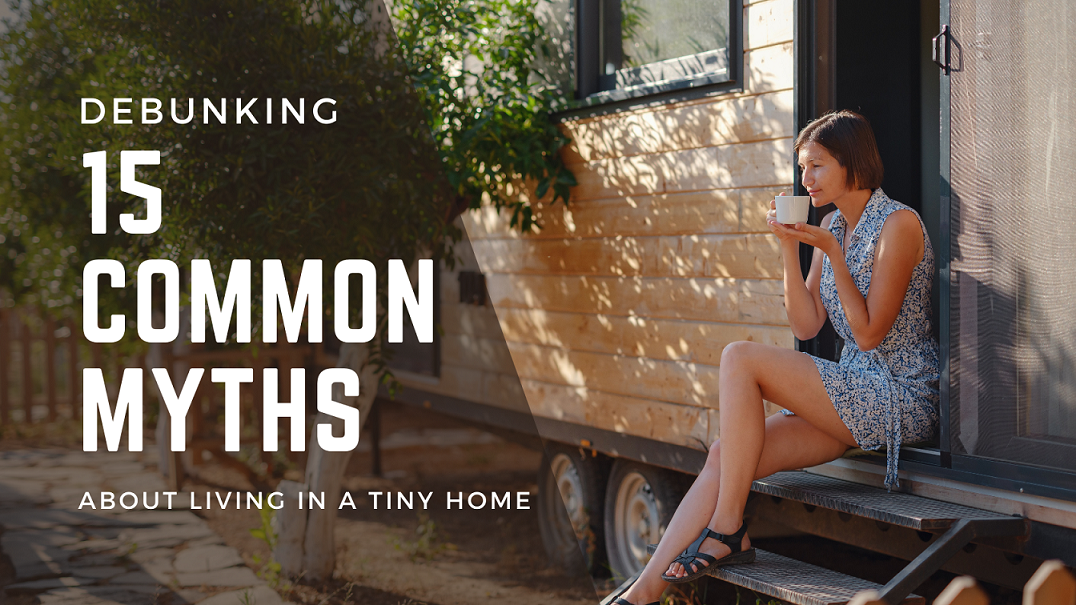
Thinking about joining the tiny house movement but worried about some of the myths you’ve heard? Despite its growing popularity, tiny house living is often misunderstood. In this guide, we debunk 15 common myths to give you a clearer picture of what tiny home life is really like. Read on to separate fact from fiction and find out if a tiny home is right for you.
Myth 1: Tiny Houses feel cramped for comfortable living.
Let’s start by debunking the most common myth surrounding tiny houses – the idea that they are cramped and uncomfortable. In fact, with smart planning and thoughtful design, tiny houses can offer an incredible level of comfort and functionality. While it’s true that living in a tiny house requires downsizing our possessions and reassessing our needs, many residents actually find the process liberating. Innovative storage solutions and multifunctional furniture can transform a tiny house into a surprisingly spacious and organized living space.
Myth 2: Tiny homes are not legally habitable.
Another of the most pervasive myths is that tiny homes are not legal dwellings. While zoning laws can be a hurdle in some areas, many jurisdictions are becoming increasingly open to the concept of tiny homes as both primary residences and accessory dwelling units. Organizations and advocates are working diligently to make tiny home living a legally recognized and viable housing option.
Myth 3: Living in a tiny house often requires sacrificing modern conveniences.
Think you have to give up all your modern conveniences to live in a tiny home? Contrary to what some may believe, tiny homes really can have all the comforts of a full-sized house—just on a smaller scale. From fully equipped kitchens with full-sized appliances to a cozy living area with high-speed internet for streaming your favorite shows, tiny homes don’t skimp on comfort.
The beauty of tiny homes is their focus on efficiency and sustainability without compromising on the essence of a comfortable lifestyle. So yes, you can absolutely brew your morning coffee, watch your favorite Netflix series, and stay connected to the world while living the tiny home life.
Myth 4: Tiny homes are not safe.
Safety is often cited as an issue when it comes to tiny homes, especially those on wheels. People worry about the structural integrity or risks of towing a home. Rest assured that most tiny homes are built to high safety standards, often exceeding those of traditional homes.
Builders are well aware of safety considerations and design homes to be strong and secure. Many tiny homes also feature advanced security systems, fire safety measures, and sturdy building materials. So, while any home requires proper care and maintenance, tiny homes are no less safe than their full-sized counterparts.
Myth 5: You can’t have pets in a tiny home.
Another misconception is that tiny houses are not suitable for pets. People imagine a cramped space where a pet couldn’t possibly be happy. Yet, many tiny home dwellers live in harmony with their four-legged friends. Thoughtful design, including custom-built pet spaces, secure outdoor areas, and even mini pet doors, can create a comfortable living environment for pets.
Living in a tiny home can also promote more outdoor activities, which benefits both humans and pets alike.
Myth 6: Tiny homes can’t be financed.
A prevalent myth is that you can’t secure a mortgage or loan for a tiny home, making them an option only for those who can pay all upfront costs. There are actually a variety of financing options available specifically for tiny homes. From specialized lenders focusing on tiny home loans to personal loans and RV loans for mobile tiny homes, there are financial pathways for those interested but lacking the initial capital. So, no, you don’t have to be wealthy or financially unburdened to start your tiny living journey.
Myth 7: Tiny houses are best suited for individuals or couples without children.
If you’ve ever heard that tiny homes are only for individuals or couples without children, it’s time to think again. Families with children are increasingly stepping into the world of tiny living, and with a little creativity, it’s absolutely doable!
The crux of the matter lies in the innovative design. Features like bunk beds, loft spaces for play or study, and areas that serve multiple purposes can transform a tiny home into a family-friendly abode. In addition to being a practical living solution, tiny homes also offer children a unique learning experience. They provide an early introduction to sustainable living and instill values of minimalism and conscious consumption – valuable lessons that will stay with them for life.
Myth 8: Tiny homes leave no room for hosting guests.
Contrary to popular belief, entertaining guests in a tiny home is completely possible. It’s true that your days of hosting dinner parties for large crowds may need some rethinking, but who says you can’t enjoy social gatherings in a tiny home? In fact, tiny houses often create a more intimate and personal environment that can make gatherings even more special.
Plenty of tiny homes are designed with socializing in mind, featuring features like convertible tables and folding seating that can easily accommodate guests. Some tiny houses also include outdoor spaces, perfect for an evening barbecue or a cozy dinner under the stars.
Тiny house living encourages us to redefine our idea of social gatherings, focusing less on grandeur and more on the quality of the interactions.
Myth 9: Tiny living isn’t feasible for seniors.
Many people think that tiny living is for young people and unsuitable for seniors who might have mobility issues or other special needs. In fact, tiny homes can be fantastic options for seniors looking for a more manageable living space. Single-level designs, customized amenities, and lower maintenance requirements make tiny homes an appealing choice for older adults.
Tiny home communities often provide a strong sense of community and support, which can be particularly helpful for older people who might otherwise experience loneliness or isolation.
Myth 10: You can’t work from home in a tiny house.
Contrary to this belief, many tiny homes are designed to include workspaces that are just as functional as those in a traditional home. With smart design solutions such as folding desks and multifunctional furniture, you can easily create a comfortable and productive work environment. As remote work becomes more common, tiny homes are evolving to meet this demand, proving that you don’t need a big house to have a functional home office.
Myth 11: Tiny living means isolation.
The idea that tiny living leads to a lonely, isolated existence is not only misleading but completely unfounded. Tiny homes, especially those within a community, are often catalysts for а stable social life. These communities often include common areas designed for socialization, from community gardens to shared recreational spaces.
The close-knit setting of tiny home communities actually tends to strengthen social bonds. Unlike traditional neighborhoods where homes are separated by large yards or barriers, tiny home communities are planned with social interaction in mind.
Myth 12: Tiny homes depreciate like cars.
Some people equate tiny homes, especially those on wheels, to vehicles, believing that they depreciate in value over time. While it’s true that some types of tiny homes can depreciate, many actually increase in value, especially those built with high-quality materials and craftsmanship. The land on which a stationary tiny home resides can also appreciate, adding to its overall value.
Myth 13: Tiny living is only for the financially constrained.
There’s a common misconception that only those who can’t afford a “regular” home choose a tiny one. While it’s true that tiny homes are generally less expensive, people of all income levels are attracted to the tiny home lifestyle for its various other benefits, such as a smaller carbon footprint and a simpler, more intentional way of living.
Myth 14: All tiny homes look alike.
Given their size and some architectural limitations, there’s an assumption that there’s not much variety in the design of tiny homes. The world of tiny homes is incredibly diverse, each reflecting the unique tastes and needs of its inhabitants. From modern, sleek designs with large windows and open concepts to cozier, cabin-like homes with warm woods and fireplaces, the design options are as varied as those in the traditional housing market.
Myth 15: Tiny Homes are a passing trend.
Many skeptics argue that tiny homes are just a fad that will disappear as quickly as they became popular. While tiny living may have gained media attention in recent years, the concepts behind it—simplicity, sustainability, and efficient use of space—are age-old principles that resonate with many.
The challenges of modern living, such as skyrocketing real estate prices and environmental concerns, make tiny homes a practical and long-lasting solution. Far from being a passing trend, tiny living addresses enduring issues, making it a lifestyle choice with staying power.
Conclusion
Tiny living offers a wide range of benefits, from a close-knit community to a more sustainable lifestyle. By debunking these myths, we hope to offer a more accurate and comprehensive understanding of what tiny home living can really offer. Far from being a short-lived trend or a lifestyle filled with sacrifices, tiny living is a viable, enriching, and flexible option for people from all walks of life.
